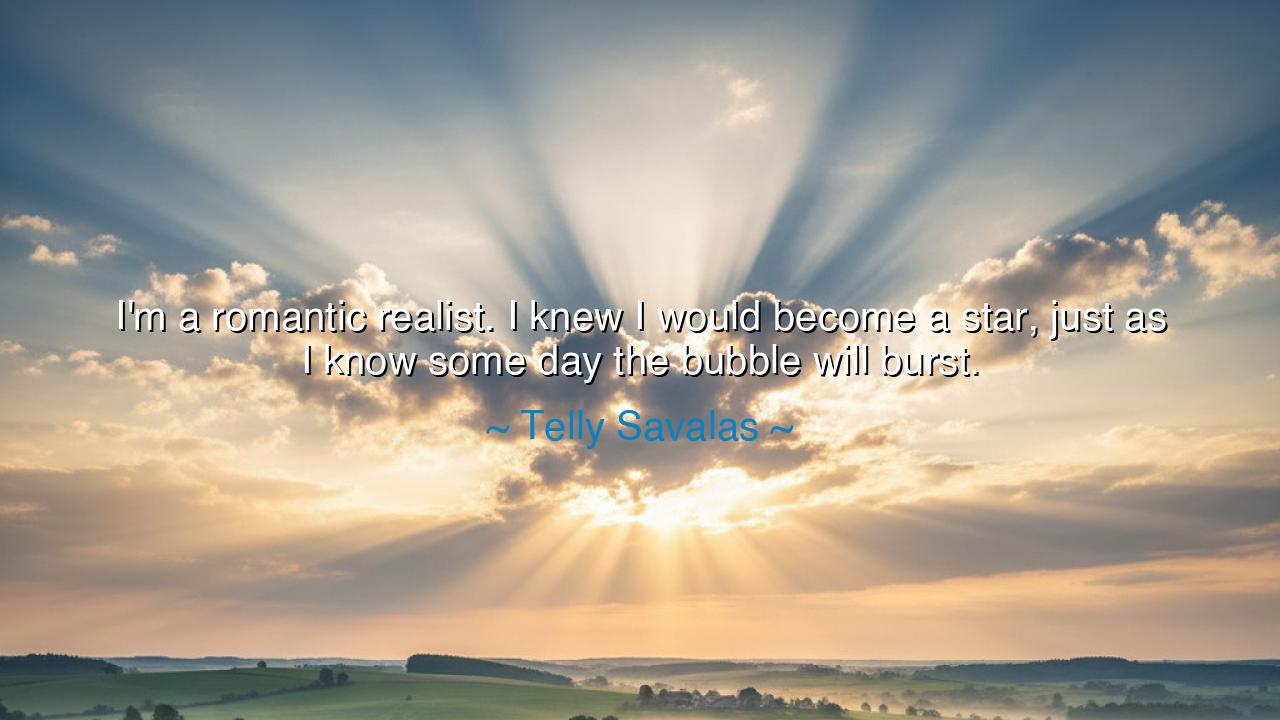
I'm a romantic realist. I knew I would become a star, just as I
I'm a romantic realist. I knew I would become a star, just as I know some day the bubble will burst.






Hear the bold declaration of Telly Savalas, who once said: “I’m a romantic realist. I knew I would become a star, just as I know some day the bubble will burst.” In these words lies a union of opposites, a paradox that reflects the true nature of life itself. To be a romantic realist is to walk with one foot in the dream and the other on the solid ground of truth. It is to hope with fire but to accept with steel, to reach for the heavens even while knowing that gravity will one day pull us back to earth.
The romantic sees destiny in the stars, believing in greatness, in love, in triumph. The realist, however, knows that glory is fleeting, that every triumph carries within it the seed of decline. Savalas, who rose from humble beginnings to become one of Hollywood’s most distinctive figures, understood both. He dared to dream of stardom, to envision himself as luminous, as unforgettable. But he also foresaw the end, the inevitable fading of applause, the silence after the spotlight. This dual vision is not despair—it is wisdom.
History has always honored those who carried both dream and realism within their hearts. Consider Alexander the Great: he dreamed of conquering the world, and for a time, he did. Yet even in his victories he confessed to his companions that glory is fragile, that empires rise and fall like the tides. Or think of Marcus Aurelius, emperor and philosopher, who sat upon the throne of Rome and wrote in his Meditations that all fame is fleeting, that the voices praising him would soon turn to dust. Such men, like Savalas, were romantic realists—dreamers who also embraced impermanence.
The phrase “the bubble will burst” carries its own rich meaning. The bubble is beauty, success, and illusion all at once—radiant, fragile, rising high yet destined to collapse. Artists, kings, and lovers all live within bubbles of hope and triumph. But every bubble bursts. To know this, and yet still to dream, is the essence of strength. For the weak deny the bursting and cling blindly to illusion; the cynic denies the bubble altogether. Only the wise accept both: the wonder of the bubble and the certainty of its end.
Savalas teaches us that this balance is the key to enduring life’s highs and lows. The one who is only a romantic will be shattered when the bubble bursts, for they believed the dream eternal. The one who is only a realist will never taste the sweetness of rising, for they never dared to hope. But the romantic realist drinks deeply from both cups: daring to rise, prepared to fall, yet never embittered by either.
The lesson for us, then, is to live boldly yet humbly. Dream of greatness, but do not be chained to it. Enjoy the moment when the crowd applauds, but know the silence will come—and do not fear it. Build your life upon both hope and acceptance. Let your heart soar like the romantic, but let your mind anchor you like the realist. In this balance lies resilience, freedom, and wisdom.
Therefore, children of tomorrow, embrace Savalas’s path. Be a romantic realist in your own life. Strive for what you love, imagine what is possible, and when your bubble rises, rejoice in its beauty. And when it bursts, do not despair—for another bubble may rise, or perhaps, in the quiet afterward, you will discover a deeper peace.
Thus his words, born of the stage and the spotlight, become timeless counsel: to dream without illusion, to accept without bitterness. This is the way of the romantic realist—the way of one who lives fully, knowing both the triumph and the transience of the human story.






AAdministratorAdministrator
Welcome, honored guests. Please leave a comment, we will respond soon